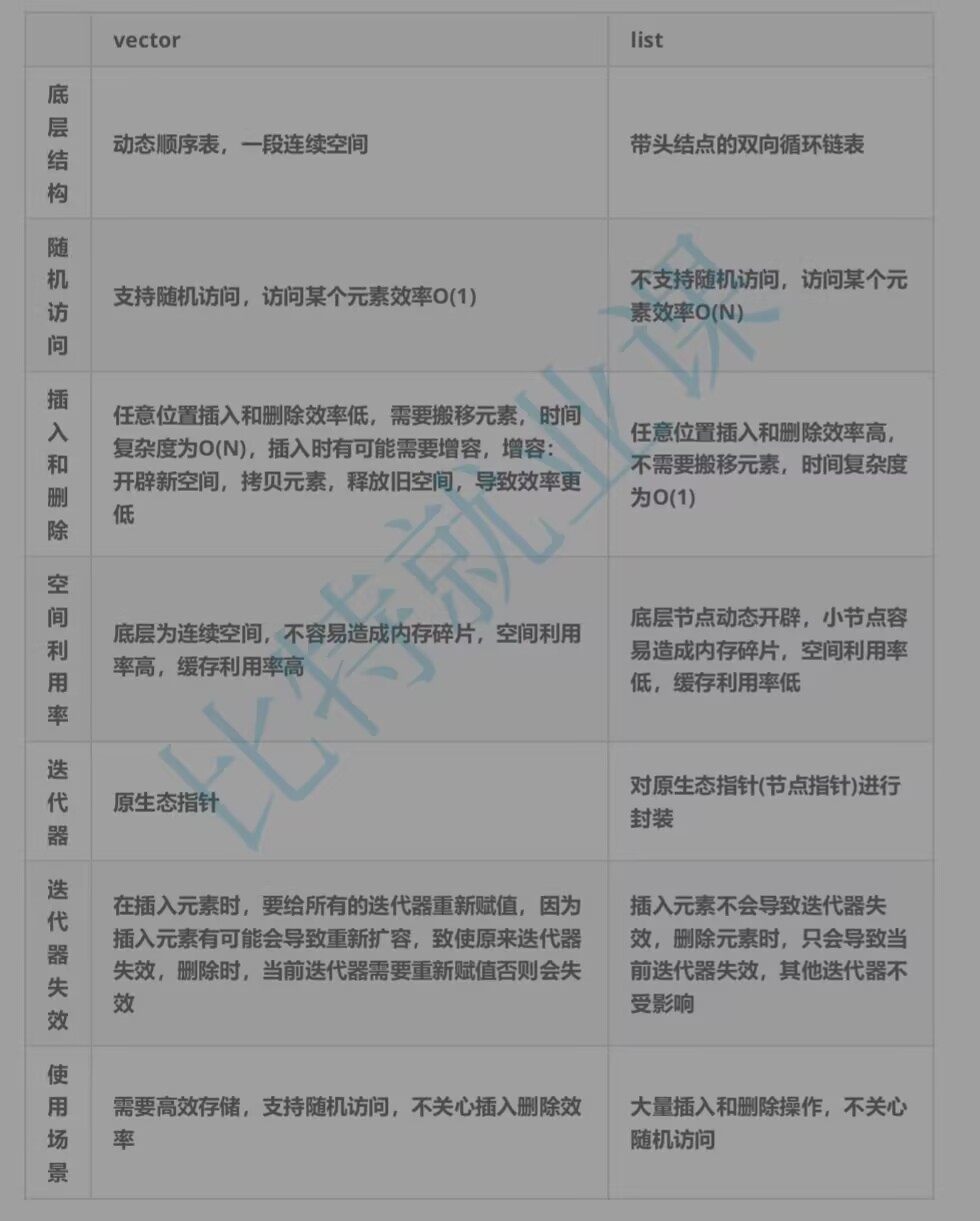list,咕咕咕!
1.list的介绍与使用
list是环状双向串行的,有prev,next结点。
list(size_type n,const value_type& val=value_type())
n个val值元素构造
list() 构建空的list
list(const list& x) 拷贝构造函数
list(inputlterator first,inputlterator last)
用(first,last)区间中的元素构造listList iterator
begin()+end() 返回第一个元素的迭代器+返回最后一个元素下一个位置的迭代器
rbegin()+rend() 返回end位置+返回begin位置
list的迭代器是双向迭代器,不是随机迭代器,不支持[]随机访问empty 检测list是否为空,是返回true,否返回false
size 返回list有效节点的个数front 返回list第一个节点中值的引用
back 返回list最后一个节点中值的引用push_front 在list首元素前插入值为val的节点
pop_front 删除list第一个节点
push_back 在尾部插入值为val的节点
pop_back 删除list最后一个元素
insert 在list position位置插入值为val的节点
erase 删除list position位置的元素
swap 交换list中2个元素
clear 清空list中的有效元素
list的迭代器也会失效,类似于指针,迭代器失效即迭代器指向的节点无效,该节点被删除了,list的底层结构为带头结点的双向循环链表,在list中插入时是不会导致list的迭代器失效,只有在删除时会失效,erase,失效的只是指向被删除节点的迭代器,其他没事。
// 链表节点类(声明与实现合并)template<class T>struct ListNode{T _val;ListNode<T>* _pPre;ListNode<T>* _pNext;// 构造函数ListNode(const T& val = T()): _val(val), _pPre(nullptr), _pNext(nullptr){}};// 链表迭代器类(声明与实现合并)template<class T, class Ref, class Ptr>struct ListIterator{typedef ListNode<T>* PNode;typedef ListIterator<T, Ref, Ptr> Self;PNode _pNode;// 构造函数ListIterator(PNode pNode = nullptr) : _pNode(pNode) {}ListIterator(const Self& l) : _pNode(l._pNode) {}// 解引用操作Ref operator*() { return _pNode->_val; }Ptr operator->() { return &(_pNode->_val); }// 前置++Self& operator++(){_pNode = _pNode->_pNext;return *this;}// 后置++Self operator++(int){Self temp(*this);_pNode = _pNode->_pNext;return temp;}// 前置--Self& operator--(){_pNode = _pNode->_pPre;return *this;}// 后置--Self operator--(int){Self temp(*this);_pNode = _pNode->_pPre;return temp;}// 比较操作bool operator!=(const Self& l) const { return _pNode != l._pNode; }bool operator==(const Self& l) const { return _pNode == l._pNode; }};// 链表主体类(声明与实现合并)template<class T>class list{typedef ListNode<T> Node;typedef Node* PNode;public:typedef ListIterator<T, T&, T*> iterator;typedef ListIterator<T, const T&, const T*> const_iterator;public:// 构造函数:创建空链表(仅头节点)list(){_pHead = new Node;_pHead->_pPre = _pHead;_pHead->_pNext = _pHead;}// 填充构造:n个值为value的节点list(int n, const T& value = T()){_pHead = new Node;_pHead->_pPre = _pHead;_pHead->_pNext = _pHead;for (int i = 0; i < n; ++i){push_back(value);}}// 迭代器区间构造template <class Iterator>list(Iterator first, Iterator last){_pHead = new Node;_pHead->_pPre = _pHead;_pHead->_pNext = _pHead;while (first != last){push_back(*first);++first;}}// 拷贝构造list(const list<T>& l){_pHead = new Node;_pHead->_pPre = _pHead;_pHead->_pNext = _pHead;const_iterator it = l.begin();while (it != l.end()){push_back(*it);++it;}}// 赋值运算符list<T>& operator=(list<T> l){swap(l);return *this;}// 析构函数~list(){clear();delete _pHead;_pHead = nullptr;}// 迭代器 begin/enditerator begin() { return iterator(_pHead->_pNext); }iterator end() { return iterator(_pHead); }const_iterator begin() const { return const_iterator(_pHead->_pNext); }const_iterator end() const { return const_iterator(_pHead); }// 容量操作size_t size() const{size_t count = 0;const_iterator it = begin();while (it != end()){++count;++it;}return count;}bool empty() const { return _pHead->_pNext == _pHead; }// 元素访问T& front(){if (empty()) throw std::out_of_range("list is empty");return _pHead->_pNext->_val;}const T& front() const{if (empty()) throw std::out_of_range("list is empty");return _pHead->_pNext->_val;}T& back(){if (empty()) throw std::out_of_range("list is empty");return _pHead->_pPre->_val;}const T& back() const{if (empty()) throw std::out_of_range("list is empty");return _pHead->_pPre->_val;}// 元素修改void push_back(const T& val) { insert(end(), val); }void pop_back() { erase(--end()); }void push_front(const T& val) { insert(begin(), val); }void pop_front() { erase(begin()); }// 在pos前插入节点iterator insert(iterator pos, const T& val){PNode newNode = new Node(val);PNode posNode = pos._pNode;newNode->_pPre = posNode->_pPre;newNode->_pNext = posNode;posNode->_pPre->_pNext = newNode;posNode->_pPre = newNode;return iterator(newNode);}// 删除pos位置节点iterator erase(iterator pos){if (pos == end()) throw std::invalid_argument("cannot erase end iterator");PNode posNode = pos._pNode;PNode nextNode = posNode->_pNext;posNode->_pPre->_pNext = nextNode;nextNode->_pPre = posNode->_pPre;delete posNode;return iterator(nextNode);}// 清空所有节点void clear(){iterator it = begin();while (it != end()){it = erase(it);}}// 交换两个链表void swap(list<T>& l) { std::swap(_pHead, l._pHead); }private:PNode _pHead; // 头节点(哨兵节点)}; // 反向迭代器模板(适配器)// Iterator:正向迭代器类型;Ref:引用类型;Ptr:指针类型template<class Iterator, class Ref, class Ptr>struct Reverse_iterator {typedef Reverse_iterator<Iterator, Ref, Ptr> Self;Iterator _it; // 存储正向迭代器// 构造函数:用正向迭代器初始化Reverse_iterator(Iterator it) : _it(it) {}// 解引用:反向迭代器的*实际访问正向迭代器的前一个元素Ref operator*() const {Iterator tmp = _it; // 拷贝当前正向迭代器--tmp; // 指向前一个元素return *tmp; // 返回前一个元素的引用}// 箭头操作符:返回前一个元素的指针Ptr operator->() const {return &(operator*()); // 复用*操作}// 前置++:反向迭代器向前移动(对应正向迭代器向后移动)Self& operator++() {--_it; // 正向迭代器--,反向迭代器实际向前走return *this;}// 前置--:反向迭代器向后移动(对应正向迭代器向前移动)Self& operator--() {++_it; // 正向迭代器++,反向迭代器实际向后走return *this;}// 不等比较:判断两个反向迭代器是否不同bool operator!=(const Self& other) const {return _it != other._it;}2.list与vector对比

